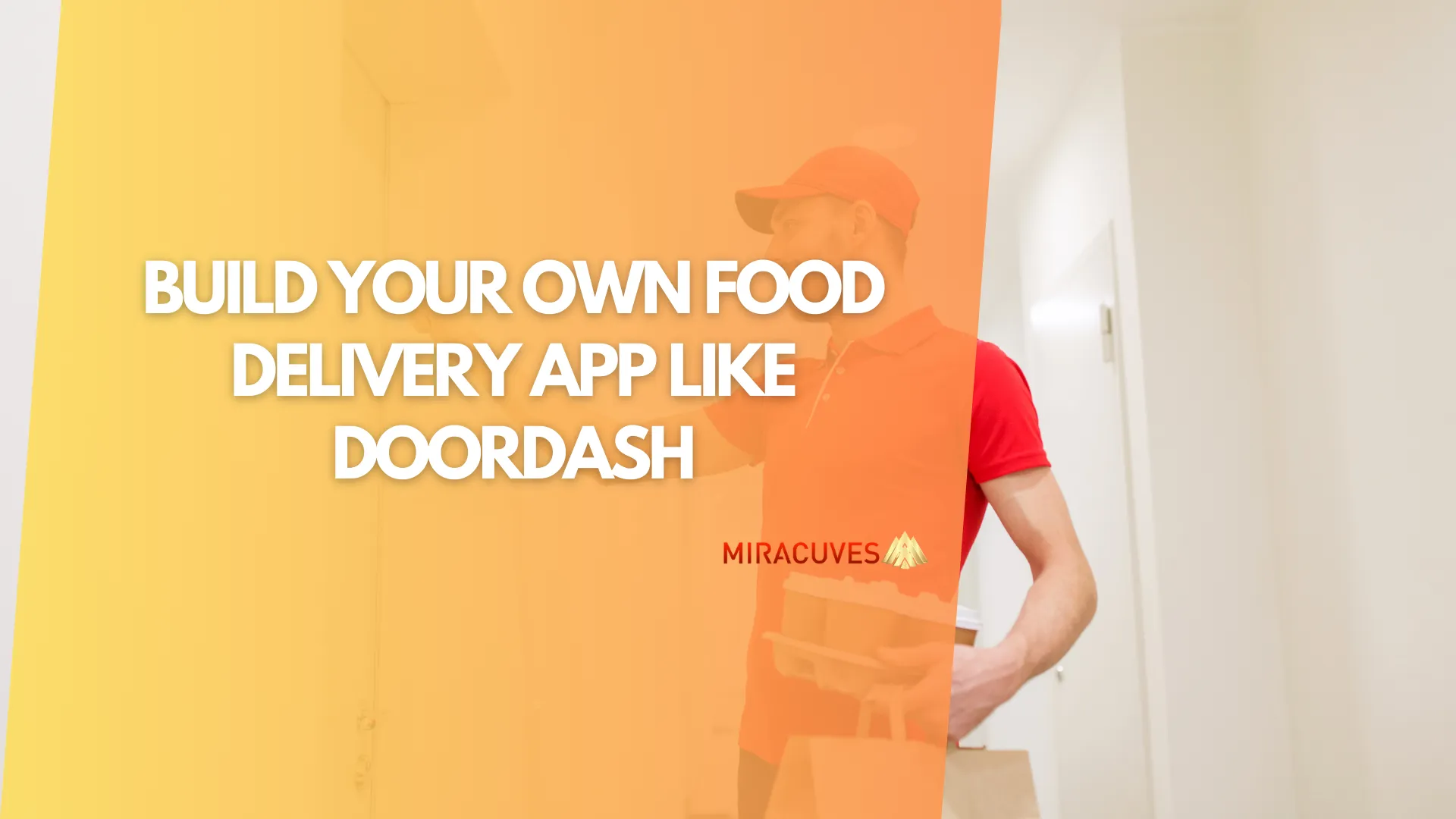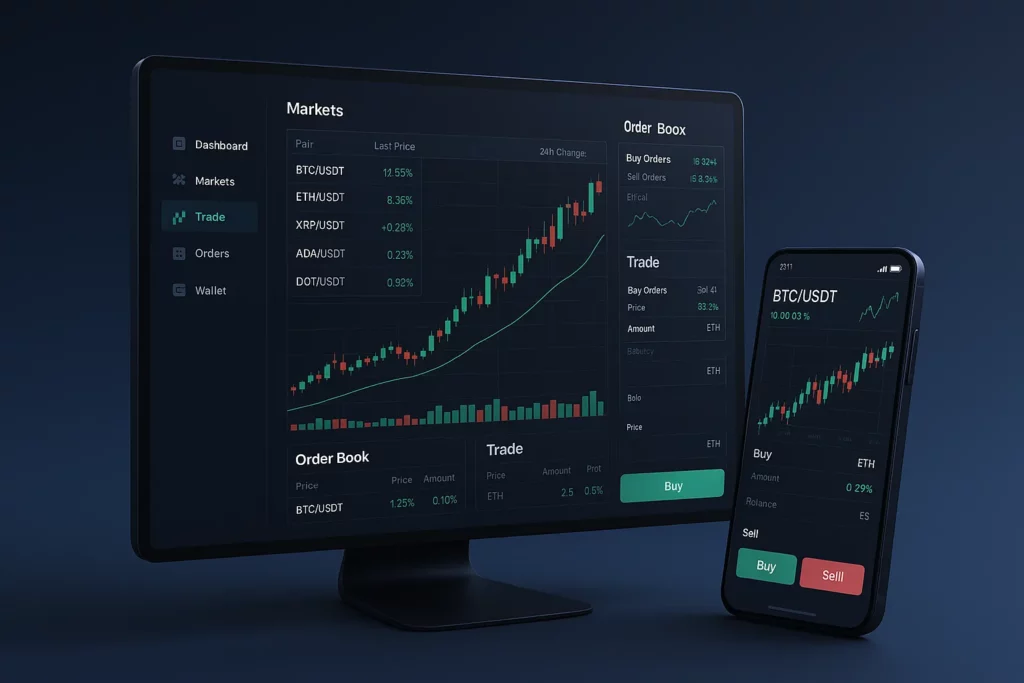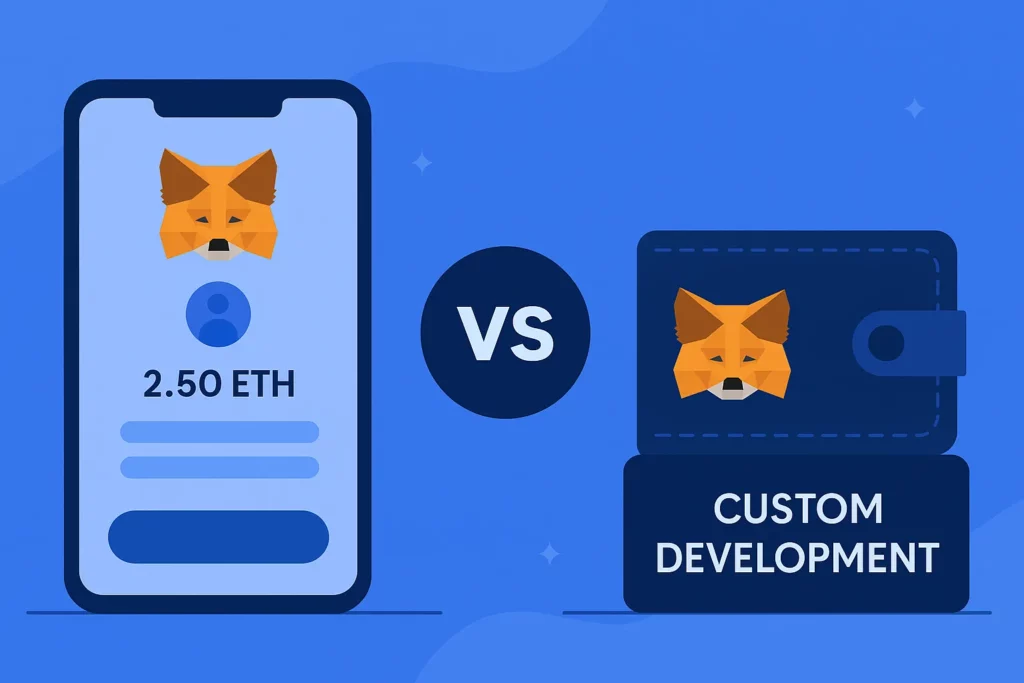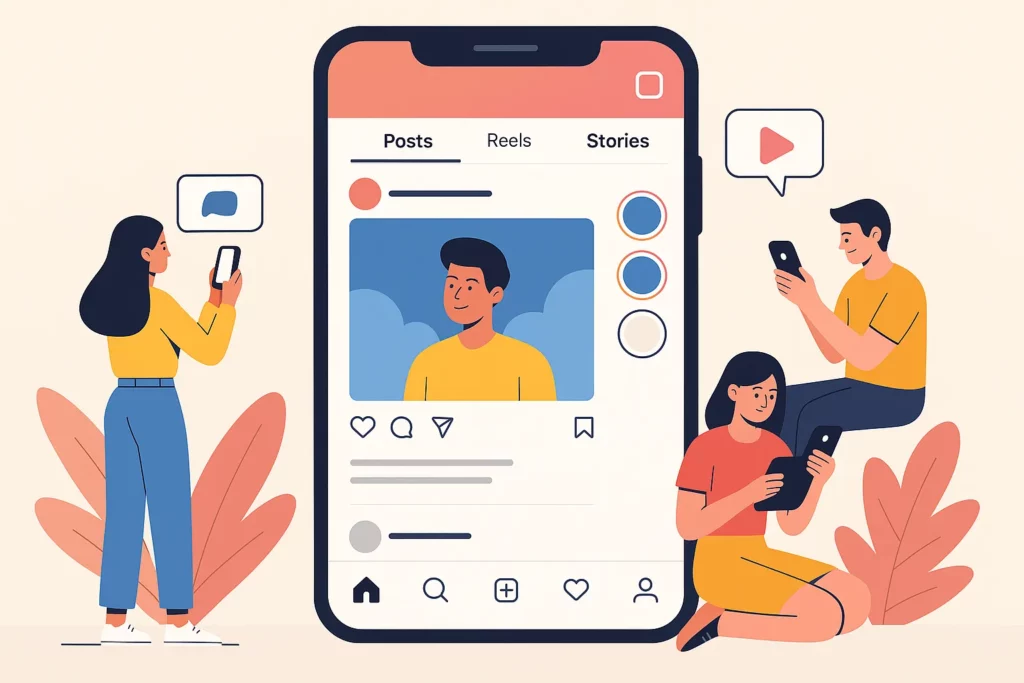In the rapidly evolving digital landscape, on-demand food delivery apps have become an integral part of modern living. Platforms like DoorDash have revolutionized how people order food, making it more convenient for customers to enjoy their favorite meals from local restaurants at the click of a button. As consumer demand for food delivery continues to grow, building a food delivery app like DoorDash presents a lucrative business opportunity for entrepreneurs. Whether you’re looking to create a DoorDash clone or develop a unique restaurant delivery platform, understanding the development process, key features, and cost is essential to success.
In this guide, we’ll explore how to build your own food delivery app, covering everything from market trends to technical requirements and the overall development process. With the right strategy, you can tap into the booming online food ordering system industry and create a sustainable, scalable business.
Also Read :- How to Build a Grocery Delivery App Like FreshDirect
What is DoorDash and What Does It Do?
DoorDash is one of the leading on-demand food delivery platforms in the world, connecting customers with their favorite local restaurants through a user-friendly app. Founded in 2013, the app quickly gained popularity due to its seamless integration of restaurants, delivery drivers, and customers. The platform offers a hassle-free way to browse restaurant menus, place orders, and have food delivered directly to your door.
At its core, DoorDash operates as a restaurant delivery platform, allowing customers to select from a wide variety of restaurants, pay online, and track their deliveries in real time. It also benefits restaurants by expanding their reach to new customers and providing delivery infrastructure without requiring the restaurant to hire its own drivers. On the delivery side, DoorDash offers flexible opportunities for drivers (known as Dashers) to earn money by delivering orders at their convenience.
Key functionalities of DoorDash include:
- Restaurant Listings: Customers can browse menus and place orders from partnered restaurants.
- Real-time GPS Tracking: Both customers and drivers can track orders from the moment they’re placed until they are delivered.
- Payment Gateway: Secure in-app payment options that streamline the ordering process.
- Customer Reviews: Customers can rate their dining and delivery experience, helping maintain quality on the platform.
With these key components, DoorDash has become a vital service in the food delivery ecosystem, making it a top choice for consumers and restaurants alike.
Why Build a Food Delivery App Like DoorDash?
The demand for on-demand food service apps has skyrocketed in recent years. With busy lifestyles, customers now expect quick, convenient access to their favorite meals. This growing trend has made food delivery apps like DoorDash a staple in urban and suburban areas alike. Building a food delivery app similar to DoorDash presents an incredible opportunity for entrepreneurs looking to enter the thriving food tech market.
One of the key reasons to create a DoorDash competitor or alternative is the scalability of the business model. As more customers turn to online platforms for food delivery, the potential for revenue growth expands. Additionally, the business benefits both restaurants and drivers, creating a seamless ecosystem that drives demand from multiple angles.
Here’s why building a food delivery app like DoorDash is a smart move:
- Growing Market: The global food delivery market is expected to surpass $300 billion by 2029, driven by changing consumer preferences and increased smartphone usage.
- Multiple Revenue Streams: You can generate revenue through delivery fees, service charges, and partnerships with restaurants, making the business model financially sustainable.
- Flexibility and Scalability: By building a scalable app, you can start locally and expand to new cities and regions as your business grows.
- Consumer Demand: As consumers seek more convenient ways to enjoy meals at home, the need for reliable, efficient food delivery apps continues to rise.
By building a DoorDash alternative, you can tap into this growing market while offering unique features that differentiate your app from existing platforms.
Also Read :- Instacart Business Model: How It Works and Success Factors
Market Size, Growth, and Revenue Model
| Revenue Model | Description | Example |
|---|---|---|
| Delivery Fees | Charge customers a fee for delivering their food, which may vary based on distance or time of day. | A flat $2.99 delivery fee for every order. |
| Service Fees | A percentage fee added to the customer’s order to cover platform operational costs. | 10% service fee on the total order amount. |
| Restaurant Commissions | Charge restaurants a commission for every order placed through your app. | 15% commission per restaurant order. |
| Subscription Models | Offer premium memberships with benefits like free delivery or discounts for members. | $9.99/month for unlimited free delivery. |
| In-App Advertising | Allow restaurants or third parties to advertise on your platform, generating additional ad revenue. | Restaurants pay to be promoted in the app. |
The food delivery industry has experienced unprecedented growth in recent years, driven by consumer convenience and digital advancements. In 2023, the global food delivery market was valued at approximately $160 billion, and it’s projected to more than double, reaching over $300 billion by 2029. This rapid growth is fueled by increased smartphone adoption, rising disposable incomes, and changing consumer behavior, where convenience is prioritized.
For entrepreneurs building a DoorDash clone or an on-demand food service app, understanding the market size and growth potential is crucial. The food delivery sector is a fast-growing industry that offers a wealth of opportunities for startups and businesses to capitalize on. As demand grows, platforms like DoorDash have paved the way, demonstrating the profitability of a restaurant delivery platform model.
Revenue Model
The success of a food delivery app lies in its diverse revenue streams. Here are some common ways to monetize your app:
- Delivery Fees: Charge customers a fee for delivering their food. This fee can vary based on distance, time of day, or restaurant type.
- Service Fees: A small service fee is added to customer orders, typically a percentage of the total order value.
- Restaurant Commissions: Earn a commission from restaurants for every order placed through your app. This is one of the primary revenue drivers for platforms like DoorDash.
- Subscription Models: Offer premium memberships that provide customers with perks like free delivery or discounts on large orders.
- In-App Advertising: Allow restaurants or related businesses to promote their services within your app, generating additional income.
By tapping into multiple revenue models, a food delivery app can quickly scale and become profitable while serving both customers and restaurants.
Also Read :- Build an App Like Zomato
How to Differentiate Your App in the Market
The food delivery market is highly competitive, with major players like DoorDash, UberEats, and Grubhub dominating the landscape. However, creating a DoorDash competitor offers plenty of opportunities if you focus on differentiation. Building a successful food delivery app isn’t just about replicating the features of existing platforms—it’s about offering something unique that caters to the specific needs of your target audience. To stand out, you need to add features and strategies that make your app more appealing to customers, restaurants, and delivery drivers.
Key Differentiation Strategies:
- Focus on Niche Markets: Rather than trying to serve everyone, target a specific market segment. For example, you can create a restaurant delivery app that focuses on healthy food, vegan options, or local gourmet restaurants.
- Offer Enhanced Customer Experience: Provide real-time order tracking, live chat support, or even AI-based recommendations to elevate the user experience.
- Incorporate Loyalty Programs: Offer rewards, discounts, or cashback for frequent users to encourage customer retention.
- Eco-Friendly Delivery Options: Differentiate by offering sustainable packaging and using eco-friendly delivery methods like bicycles or electric vehicles.
- Specialized Delivery Schedules: Offer late-night or early-morning delivery services, which can capture customers outside of regular dining hours.
Custom Features to Consider:
- Multiple Payment Methods: Ensure your app supports various payment options, including digital wallets and crypto, for user convenience.
- Multi-Language and Multi-Currency Support: Make your app accessible globally with different languages and currencies.
- Driver Rewards System: Create incentives for delivery drivers by offering bonuses for quick deliveries or excellent customer service.
By incorporating these custom features and focusing on underserved market segments, you can set your food ordering solution apart from competitors like DoorDash.
Key Features of a DoorDash-Like App
| Feature | Description | Importance |
|---|---|---|
| User Registration and Profiles | Allows users to sign up, create profiles, and save order history and payment information. | Improves user convenience and personalizes the experience. |
| Restaurant Listings and Menus | Displays restaurants with searchable, filterable menus, ratings, and reviews. | Helps users find the best options quickly and encourages more orders. |
| Real-Time GPS Tracking | Lets users and drivers track deliveries in real-time, with route optimization for drivers. | Enhances user satisfaction and improves delivery efficiency. |
| Order Management System | Facilitates placing, editing, and canceling orders, with real-time updates for users and restaurants. | Streamlines the ordering process and improves communication between users and restaurants. |
| Payment Gateway Integration | Supports multiple payment options like credit cards, PayPal, and digital wallets. | Ensures secure, convenient payments, reducing friction in the checkout process. |
| Push Notifications | Sends updates on order status, promotions, and offers directly to users. | Keeps users engaged and informed, improving retention and repeat orders. |
| Driver Interface | Provides tools for delivery drivers, such as order updates, GPS, and earnings tracking. | Increases driver efficiency and ensures timely, accurate deliveries. |
| Ratings and Reviews | Allows users to rate their experience and provide feedback on restaurants and drivers. | Maintains platform quality by encouraging accountability and transparency. |
Building a successful food delivery app like DoorDash requires incorporating key features that provide both functionality and convenience for users, restaurants, and delivery drivers. These features are essential for creating a seamless experience and ensuring the app runs efficiently. Below are the fundamental features your app should include to compete effectively in the market:
1. User Registration and Profiles
Allow users to sign up via email, phone number, or social media, and create personalized profiles. This helps track order history, preferences, and payment information.
2. Restaurant Listings and Menus
A detailed list of restaurants with searchable, filterable menus. Include features like restaurant ratings, reviews, and recommendations to enhance user experience.
3. Real-Time GPS Tracking
This is a crucial feature in any food delivery app. Customers should be able to track their order in real-time, from the moment it’s placed to the time it’s delivered. Delivery drivers should also have access to optimized routes for efficient deliveries.
4. Order Management System
A seamless process that allows users to place, edit, and cancel orders effortlessly. Restaurants need a system to receive orders and update the status in real-time, which is also displayed to the customers.
5. Payment Gateway Integration
Multiple payment options, including credit/debit cards, PayPal, and digital wallets, should be available for customers. Secure and fast payments are vital to the success of your online food ordering system.
6. Push Notifications
Keep users updated with order status, promotions, and offers through push notifications. This feature helps retain customers by keeping them engaged with your platform.
7. Driver Interface
Delivery drivers need their own set of tools, including real-time order updates, GPS tracking, and earnings tracking. Features like route optimization can help reduce delivery time and improve efficiency.
8. Ratings and Reviews
Allow customers to rate their delivery experience and provide feedback on the food and the driver’s service. This feature helps maintain quality and transparency on the platform.
By integrating these essential features, you can create a fully functional food delivery app that offers a competitive, user-friendly experience similar to DoorDash.
Build Your Own DoorDash-Style App!
From restaurant onboarding to last-mile delivery tracking,
we create food delivery solutions that scale.
Ready to serve success on every plate?
Minimum Viable Product (MVP)
When developing a food delivery app like DoorDash, it’s smart to start with a Minimum Viable Product (MVP). An MVP is a simplified version of your app that includes only the most essential features. This allows you to enter the market quickly, gather feedback from early users, and refine the app before investing in full-scale development. By focusing on core functionality, you can minimize costs and reduce development time while ensuring the app meets the needs of customers and delivery drivers.
Why Launch with an MVP?
- Faster Time to Market: Developing a full-featured app can take months, but an MVP allows you to launch quickly with a functional product. This helps you stay ahead of competitors.
- Cost Efficiency: By focusing only on core features, you reduce the upfront investment needed for development. Once the MVP is successful, you can add advanced features based on real user feedback.
- Testing Product-Market Fit: An MVP enables you to test how well your online food ordering system meets market demand before fully committing to building additional features.
- User Feedback and Iteration: Early adopters provide valuable insights into what’s working and what needs improvement. This feedback allows you to enhance your app in future updates, ensuring that your final product better aligns with user expectations.
Key Features of an MVP:
- User Registration and Log-in: Allow basic sign-up and profile creation.
- Restaurant Listings: Include a simple search and filter option for users to find nearby restaurants.
- Order Placement: Users should be able to place orders with a few clicks.
- Payment Gateway: Integrate a secure payment system with at least one payment option.
- Real-Time GPS Tracking: Ensure users can track their delivery status from restaurant to door.
- Push Notifications: Send updates about order status and promotions.
Starting with an MVP enables you to minimize risks while still offering a high-quality restaurant delivery platform.
Technical Requirements
| Component | Option 1 | Option 2 | Impact on Scalability, Cost, and Development Speed |
|---|---|---|---|
| Frontend | React Native | Flutter | Both are ideal for cross-platform apps. React Native has a larger developer community, making it easier to find support, while Flutter offers better performance in some cases. |
| Backend | Node.js | Python (Django) | Node.js is known for high scalability and speed, ideal for real-time apps. Django is robust for large-scale applications and is highly secure. |
| Database | MongoDB | MySQL | MongoDB is flexible and scales easily with unstructured data. MySQL is reliable for structured data and widely supported. |
| Payment Gateway | Stripe | PayPal | Stripe offers easier integration and flexibility, while PayPal has a broad customer base and is well-known for secure transactions. |
| Cloud Hosting | Amazon Web Services (AWS) | Google Cloud | Both offer high scalability and security. AWS has a broader range of services, while Google Cloud offers strong integration with other Google products. |
| APIs | Google Maps API | Mapbox | Google Maps API is widely trusted for navigation but can be expensive. Mapbox offers more customization and is often more cost-effective for scaling. |
Building a food delivery app like DoorDash requires a solid technical foundation to ensure scalability, security, and seamless user experience. The technology stack you choose will play a critical role in the performance of your app, so it’s essential to select tools and frameworks that align with your business goals and future growth plans.
Key Components of the Technology Stack:
- Frontend Development: This is the part of the app users interact with. For food delivery apps, frameworks like React Native or Flutter are popular for building cross-platform apps (iOS and Android). These technologies allow for faster development and a consistent user experience across devices.
- Backend Development: The backend handles all the server-side logic, data storage, and business processes. A robust backend should use technologies like Node.js, Python (Django), or Ruby on Rails to process orders, manage user data, and handle payment transactions efficiently.
- Database: Your app will need a reliable database to store user data, restaurant details, and order information. Databases such as MongoDB or MySQL are widely used for handling large amounts of data while ensuring quick access and security.
- APIs (Application Programming Interfaces): To integrate essential features like GPS tracking, payment gateways, and restaurant information, you’ll need APIs. Google Maps API for navigation, Stripe or PayPal for payments, and custom APIs for restaurant data are crucial for creating a seamless experience.
- Cloud Hosting: Hosting your app on the cloud allows it to scale efficiently as your user base grows. Services like Amazon Web Services (AWS) or Google Cloud offer secure, flexible hosting options that can handle fluctuating demand.
- Security Protocols: Implement industry-standard encryption and secure socket layer (SSL) protocols to protect user data and transactions. Security is paramount in any app that handles sensitive information like payment details.
Importance of Choosing the Right Tech Stack:
- Scalability: A good tech stack ensures your app can handle increased traffic as your user base grows without performance issues.
- Cost Efficiency: By choosing open-source or widely supported technologies, you reduce long-term costs while ensuring easy maintenance.
- Speed and Performance: Optimized code and reliable infrastructure will keep your app running smoothly, enhancing user satisfaction and retention.
when discussing integrating payment options like Stripe.
Design and User Interface
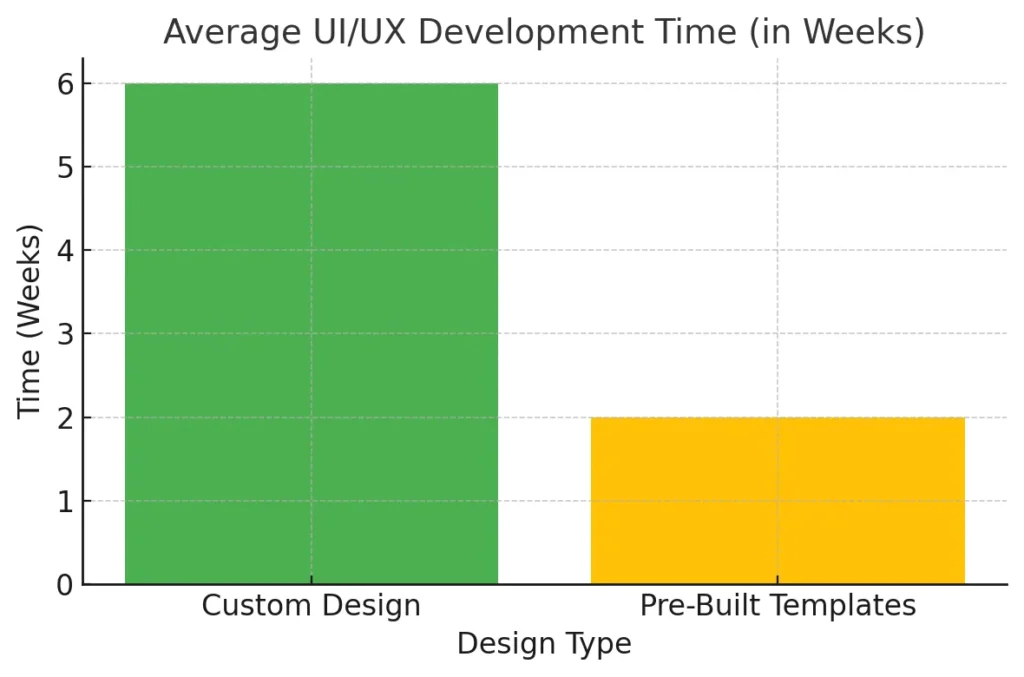
The design and user interface (UI) of your food delivery app are crucial to its success. A well-designed app not only enhances user experience but also keeps customers coming back. The goal is to create a seamless, intuitive interface that makes it easy for users to browse menus, place orders, and track deliveries without any hassle. Whether it’s for customers, restaurants, or delivery drivers, a smooth UI/UX (user experience) design can be a significant differentiator in the competitive food delivery market.
Key Considerations for App Design:
- User-Friendly Navigation: Your app should be easy to navigate for all users, whether they are first-time visitors or repeat customers. Clear categories for restaurants, food types, and offers will ensure users can find what they’re looking for quickly.
- Intuitive Order Process: The ordering process should be streamlined and fast. From selecting food to checking out, the number of steps should be minimized to make it as convenient as possible for users.
- Visual Appeal: Design is not just about functionality—it’s about aesthetics too. Use clean, modern design elements with high-quality images of dishes to entice customers. A visually appealing interface can make a huge difference in encouraging users to place orders.
- Consistency Across Platforms: Whether your users are on Android or iOS, they should have a consistent experience. This is where cross-platform design using frameworks like React Native or Flutter comes into play, ensuring the app looks and feels the same on different devices.
- Driver and Restaurant Interfaces: Don’t forget about the other users of your platform—drivers and restaurant owners. The driver interface should have a simple order management system with GPS integration for efficient deliveries, while the restaurant interface should allow easy updates to menus and orders.
- Dark Mode and Accessibility Features: Offering dark mode options and features that enhance accessibility (like larger fonts or voice commands) will make your app more user-friendly for a wider audience, improving overall engagement.
Importance of UI/UX in Food Delivery Apps:
- Enhanced User Experience: A seamless, visually pleasing design makes users more likely to return and recommend the app to others.
- Increased Engagement: Features like personalized recommendations and clear call-to-action buttons can boost engagement and conversion rates.
- Customer Retention: An intuitive design with features like easy reordering and saved preferences encourages repeat usage, which is crucial for app success.
Development Process
| Development Stage | Custom Development (Time/Cost) | Readymade Solution (Time/Cost) |
|---|---|---|
| Planning and Research | 2-4 weeks / $2,000 – $5,000 | 1-2 weeks / $1,000 – $2,500 |
| Wireframing and Prototyping | 2-3 weeks / $1,500 – $3,000 | 1 week / Included in template |
| UI/UX Design | 4-6 weeks / $4,000 – $8,000 | 1-2 weeks / Included in template |
| Backend Development | 8-12 weeks / $10,000 – $20,000 | 3-5 weeks / $3,000 – $6,000 |
| Frontend Development | 6-8 weeks / $7,000 – $15,000 | 3-4 weeks / Included in template |
| Testing and Quality Assurance (QA) | 2-3 weeks / $2,000 – $5,000 | 1 week / $1,000 – $2,000 |
| Deployment and Launch | 1-2 weeks / $1,500 – $3,000 | 1 week / $1,000 – $1,500 |
Building a food delivery app like DoorDash involves a series of well-defined development stages, each playing a vital role in turning your idea into a functional, user-friendly platform. Whether you are developing from scratch or using readymade solution, understanding the development process helps in planning the project, managing resources, and meeting deadlines efficiently.
Key Stages of the Development Process:
- Planning and Research: Before you start coding, you need to understand your target audience, competitors, and market demands. This stage involves defining the app’s core features, understanding the needs of your customers, and sketching out how the app will function. Creating user personas and workflows helps guide the entire development process.
- Wireframing and Prototyping: This is where the visual layout of the app is drafted. Wireframes serve as the blueprint for your app, laying out the structure of each screen and how users will navigate between different sections. Prototyping allows for testing the flow and usability of the app before development begins.
- UI/UX Design: As discussed earlier, the user interface (UI) and user experience (UX) design play a crucial role in how customers, drivers, and restaurant partners will interact with the app. This is the phase where your wireframes turn into actual designs, and it’s important to ensure consistency and ease of use across the app.
- Backend Development: This stage involves building the server, database, and APIs that power the app. The backend handles user authentication, order management, payment processing, and interactions with third-party services like maps or payment gateways. A strong backend ensures your app runs smoothly, even with large volumes of traffic.
- Frontend Development: In parallel with backend development, the frontend focuses on the app’s visual and interactive elements. The goal is to make the app responsive, fast, and easy to use across different devices. Tools like React Native or Flutter allow developers to create apps for both iOS and Android simultaneously.
- Testing and Quality Assurance (QA): After development, extensive testing is done to identify and fix bugs. This includes functional testing, performance testing, and security checks to ensure the app is reliable and secure. User testing with real-world scenarios is also essential to validate usability before launch.
- Deployment and Launch: Once the app is ready and tested, it’s time to launch it in the app stores (Google Play and Apple App Store). This stage involves submitting the app for approval and optimizing it for better visibility through App Store Optimization (ASO) techniques.
Benefits of Using Readymade Solution in Development:
If you choose to use readymade solution, you can significantly speed up the development process by skipping the design and basic coding phases. Templates often come with pre-designed UI components and integrated backend systems, allowing you to focus on customization and refinement.
Cost Estimation and Timeframe
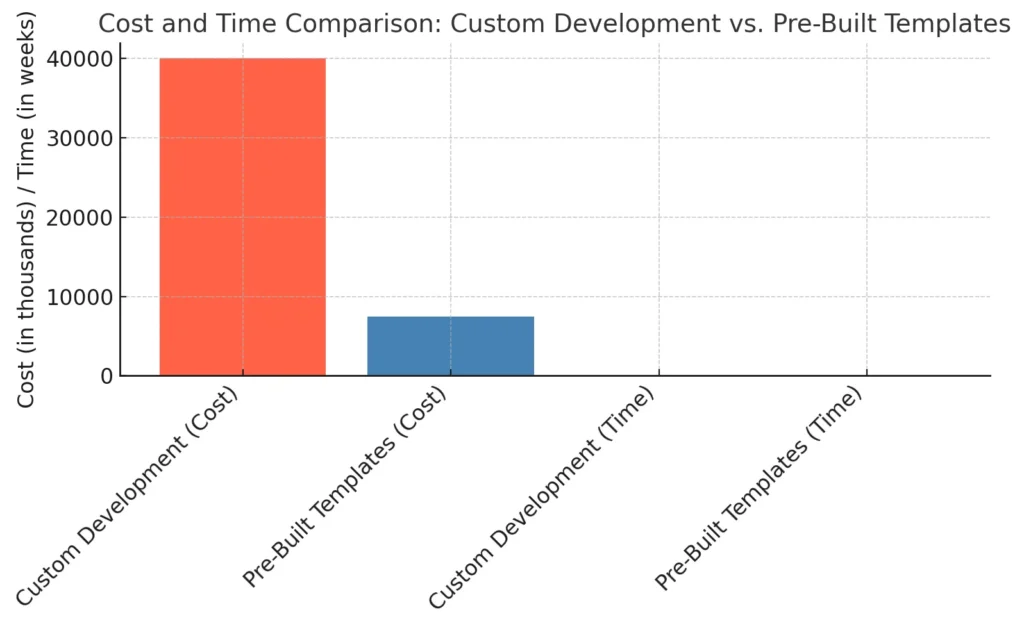
When building a food delivery app like DoorDash, one of the most critical factors to consider is the cost and the timeframe required for development. Depending on the complexity of the features, the size of your team, and whether you choose custom development or readymade solution, the costs can vary significantly.
Global Cost of Custom App Development
Developing a custom food delivery app from scratch can be expensive. The global average for building an app with features similar to DoorDash is approximately $30,000 to $50,000. This cost includes everything from designing the UI/UX to backend development, payment integration, testing, and deployment. Here’s a breakdown of the key cost drivers:
- Design: $4,000 – $8,000
- Backend and Frontend Development: $20,000 – $30,000
- Payment Integration and APIs: $2,000 – $5,000
- Testing and Quality Assurance: $2,000 – $5,000
- Deployment and Launch: $1,500 – $3,000
The development timeframe for a custom app can take anywhere from 4 to 6 months, depending on the complexity and the team’s resources.
Cost with Readymade Solution
Using readymade solution can significantly reduce both the cost and development time. Platforms that offer ready-made app designs for food delivery services allow businesses to skip many of the initial development stages, such as UI/UX design and basic backend setup. The cost for developing an app using readymade solution is typically around $5,000 to $10,000, with a much shorter timeframe of 2 to 4 weeks.
Breakdown of Costs for Readymade Solution Development:
- Template Purchase and Customization: $3,000 – $5,000
- Backend Configuration: $1,500 – $2,500
- Payment Integration: $500 – $1,000
- Testing and Deployment: $1,000 – $1,500
Timeframe Comparison
The time to market is a crucial factor in the competitive world of on-demand food services. A custom-built app can take several months to develop, while an app using readymade solution can be ready to launch in 2 to 4 weeks. By significantly reducing the development time, you can enter the market faster, start generating revenue, and iterate based on real user feedback.
Why Trust Miracuves Solutions for Your Next Food Delivery App?
In today’s fast-paced market, businesses need to launch quickly while ensuring quality and reliability. readymade solutions for food delivery apps offer an efficient way to develop a powerful platform like DoorDash without the long development timelines or high costs associated with building from scratch. But why should you trust these turnkey solutions for your next project? Let’s explore the key reasons.
1. Proven Reliability
Pre-built solutions are often based on successful and widely-used frameworks, meaning they have been tested in real-world scenarios. They come with built-in functionalities like restaurant listings, payment gateways, and GPS tracking, ensuring that the core components of your app work seamlessly from the start. You won’t be experimenting with unproven features or risking delays from coding errors.
2. Cost Efficiency
As discussed earlier, the cost of developing a food delivery app from scratch can easily exceed $40,000. By using readymade solutions, you can reduce this cost by up to 75%, keeping your budget under control while still delivering a professional app. These solutions are particularly beneficial for startups and small businesses that want to test the market without making large upfront investments.
3. Faster Time to Market
Speed is critical in the highly competitive food delivery industry. Custom app development can take several months, but a readymade solutions can get you up and running in just a few weeks. This gives you the ability to enter the market quickly, start generating revenue, and refine your app based on customer feedback. The ability to launch faster is often a key differentiator in such a crowded marketplace.
4. Customizability
Many entrepreneurs worry that turnkey solutions may lack the flexibility to accommodate unique features or branding. However, most readymade solutions are highly customizable. You can add features, change the design, and integrate third-party services to tailor the app to your specific business needs. This balance of flexibility and reliability allows you to offer a unique restaurant delivery platform without starting from scratch.
5. Ongoing Support and Updates
Reputable providers of readymade solutions often offer ongoing technical support and updates, ensuring that your app remains functional and up-to-date with the latest technology trends. This gives you peace of mind knowing that any technical issues will be addressed quickly and efficiently, helping you focus on growing your business.
Monetization Strategies
One of the key factors in building a successful food delivery app like DoorDash is establishing effective monetization strategies. While the primary function of your app is to facilitate food orders and deliveries, the real challenge lies in making it financially sustainable. Several monetization strategies can be employed to generate revenue while keeping customers, restaurants, and delivery drivers engaged.
1. Delivery Fees
This is the most common and straightforward revenue model. Every time a customer places an order, a delivery fee is charged. The amount can vary based on factors like distance, time of day, or the availability of drivers. Delivery fees are an excellent way to ensure a steady stream of income, especially during peak hours or high-demand periods.
2. Service Fees
In addition to delivery fees, your app can charge service fees to cover the operational costs of managing the platform. This fee, often a small percentage of the total order value, helps cover expenses like server maintenance, customer support, and app updates. It can be an effective way to add incremental revenue without directly affecting the cost of food for customers.
3. Restaurant Commissions
Restaurants benefit greatly from food delivery apps because they expand their customer base. In return, your app can charge them a commission on each order placed through the platform. Typically, this commission ranges from 15% to 30% of the total order value. This revenue model not only supports the app but also incentivizes restaurants to continue using the service.
4. Subscription Models
Offering a subscription model can attract frequent users by providing benefits such as free delivery, exclusive discounts, or priority support. For instance, a customer might pay a monthly fee (e.g., $9.99 per month) to enjoy unlimited free deliveries. Subscription models encourage loyalty and can significantly increase customer retention.
5. In-App Advertising
You can allow restaurants or third-party companies to advertise within your app. This can include placing featured restaurants at the top of search results or offering banner ads within the app. In-app advertising is an excellent way to generate additional revenue, particularly from restaurants looking to gain more visibility on your platform.
6. Partnered Promotions and Deals
Collaborate with restaurants to offer special deals or discounts to users. Not only does this drive more orders, but you can also take a small percentage of the revenue from these promotions. Partnered deals are a win-win, as they attract more customers while benefiting both the restaurant and the app.
Launching and Marketing the App
Launching a food delivery app like DoorDash is an exciting yet critical phase that determines how well your app will be received by the market. A well-executed launch combined with a strong marketing strategy can make the difference between a successful app and one that struggles to gain traction. To ensure your app gets the attention it deserves, you need a clear plan for both the app launch and ongoing marketing.
1. Pre-Launch Buzz
Before launching your app, it’s important to generate excitement and awareness. You can build anticipation through various channels:
- Social Media Campaigns: Use platforms like Instagram, Facebook, and Twitter to announce your app’s upcoming launch. Share sneak peeks, behind-the-scenes content, and even teaser videos to engage potential users.
- Email Marketing: Create a waitlist for people who want early access to your app. Offering exclusive deals or discounts to early sign-ups can help create a sense of urgency and encourage people to try your app as soon as it launches.
- Influencer Partnerships: Collaborate with food influencers or bloggers to promote your app. Their audience is likely already interested in food-related content, making them ideal partners for your launch.
2. App Store Optimization (ASO)
Getting your app noticed in the Google Play Store or Apple App Store is essential. App Store Optimization (ASO) helps increase your app’s visibility by using targeted keywords, engaging app descriptions, and high-quality visuals like screenshots and demo videos. The goal is to rank higher in search results, making it easier for potential users to find and download your app.
3. Local Partnerships
Since food delivery apps are location-based, forming partnerships with local restaurants and businesses is a great way to ensure you have an initial customer base. By offering discounts or special promotions in collaboration with restaurants, you can incentivize more people to use your app. This also benefits restaurants, as it helps them reach more customers through your platform.
4. Referral Programs
Referral programs are a powerful way to encourage word-of-mouth marketing. By offering discounts or credits to users who refer their friends, you incentivize existing customers to bring new users onto the platform. These programs can help accelerate growth during the initial launch phase and beyond.
5. Targeted Advertising
Investing in targeted advertising, especially on social media platforms, can help you reach your desired audience. Platforms like Facebook Ads and Google Ads allow you to target specific demographics, such as age, location, and interests, ensuring your ads are seen by people most likely to download your app.
6. Post-Launch Engagement
After the launch, maintaining user engagement is key to long-term success. Keep users engaged by offering regular promotions, new restaurant partnerships, and user-friendly updates. Continuously monitor user feedback and reviews to improve the app and ensure users stay satisfied.
Legal and Regulatory Considerations
When launching a food delivery app like DoorDash, it’s essential to address the legal and regulatory requirements to ensure compliance and avoid potential issues down the road. Operating an app that handles sensitive user data, processes payments, and manages deliveries involves adhering to a variety of laws and regulations, both local and international. Understanding these requirements is key to building a trustworthy platform.
1. Licenses and Permits
Every region has its own rules for food delivery services, so it’s important to ensure that your app complies with local regulations. You may need specific licenses or permits to legally operate, especially if your app directly handles food or partners with restaurants that require inspections. It’s crucial to consult with local authorities or legal experts to determine which permits are necessary.
2. Data Privacy and Security
With your app collecting personal information such as names, addresses, and payment details, safeguarding user data is paramount. You must comply with data protection regulations like the General Data Protection Regulation (GDPR) in Europe or California Consumer Privacy Act (CCPA) in the United States. Ensure your app has strong encryption and secure data storage protocols to protect sensitive information from breaches.
3. Payment Processing and Compliance
When integrating payment gateways like Stripe or PayPal, you need to ensure compliance with payment processing regulations, including PCI DSS (Payment Card Industry Data Security Standard). This standard is designed to protect cardholders’ information and maintain secure transactions. Failure to comply can lead to heavy fines and reputational damage.
4. Third-Party Contracts
Your app will likely partner with restaurants, delivery drivers, and payment processors. It’s important to establish clear contracts with all third-party service providers to outline responsibilities, revenue-sharing models, and liabilities. These contracts ensure that all parties are aware of their legal obligations and protect your business from potential disputes.
5. Delivery Driver Regulations
Delivery drivers may either work as independent contractors or employees, depending on your business model and local laws. If they are contractors, you’ll need to comply with regulations related to gig economy workers, including labor laws, insurance, and taxation. Providing drivers with proper training and ensuring they follow local traffic and safety laws is also essential to protect your app from legal risks.
6. Health and Safety Regulations
Since your app deals with food delivery, you’ll need to ensure that partner restaurants comply with health and safety standards. This includes food preparation, packaging, and delivery guidelines that protect the consumer. In some regions, your app may be responsible for verifying that restaurants have passed food safety inspections.
Future Growth and Scalability
Launching a food delivery app like DoorDash is just the beginning. To ensure long-term success, your app needs to be scalable and capable of handling future growth. As your user base expands, both in terms of customers and restaurant partners, your app must adapt to increasing demands without compromising on performance or user experience. A scalable app allows you to grow your business efficiently while maintaining quality service.
1. Cloud Infrastructure for Scalability
One of the key elements to ensuring your app can scale is to host it on a reliable cloud infrastructure. Services like Amazon Web Services (AWS), Google Cloud, or Microsoft Azure offer flexible, scalable solutions that allow you to handle growing numbers of users. Cloud platforms make it easier to scale both horizontally (adding more servers) and vertically (upgrading existing servers) based on user demand.
2. Load Balancing and Performance Optimization
As more users join your platform, your app’s backend must distribute traffic efficiently to prevent server overloads. Load balancing helps by distributing incoming traffic across multiple servers, ensuring smooth operation even during peak times. Additionally, continuous performance optimization—such as database tuning and code efficiency improvements—will ensure that your app runs smoothly as it scales.
3. Modular Architecture
Building your app with a modular architecture enables you to add or upgrade features without affecting the entire system. This approach not only supports faster development of new features but also makes it easier to scale specific components of the app, such as the order management system or restaurant listings, as demand grows.
4. Expanding to New Markets
Once your app has established a presence in a local or regional market, expanding to new cities or countries can drive future growth. Ensure your app is built with multi-language and multi-currency support to facilitate entry into international markets. Additionally, understanding the regulations, market preferences, and restaurant availability in new areas will help you successfully scale your app into new territories.
5. User Feedback and Continuous Improvement
Scaling successfully also requires ongoing user feedback to identify areas for improvement. Continuously collecting and analyzing customer reviews will help you enhance features, fix bugs, and provide updates that improve user experience. The more responsive you are to customer needs, the more likely you are to retain users and foster long-term growth.
6. Partnership and Network Expansion
To grow your app further, you can expand your restaurant and driver networks by forming partnerships with more local businesses. Offering exclusive deals or features to attract more restaurants and delivery drivers ensures that your app remains competitive and can meet growing demand.
Services like Amazon Web Services (AWS), Google Cloud, or Microsoft Azure offer flexible, scalable solutions that allow you to handle growing numbers of users.
Conclusion
Building a food delivery app like DoorDash offers an exciting opportunity to tap into the rapidly growing on-demand food service market. With the right strategy, technical infrastructure, and monetization model, you can create a platform that caters to both customers and restaurants while providing a seamless experience for delivery drivers. Whether you choose to develop the app from scratch or use Miracuves Solutions, the key is to focus on core features, scalability, and customer satisfaction.
By keeping costs manageable, leveraging smart marketing techniques, and staying compliant with legal requirements, your app can become a valuable player in the food delivery industry. As the demand for convenient online food ordering grows, entering this market with a well-planned app is a decision that can yield long-term success. Now is the perfect time to act and build your own restaurant delivery platform that competes with industry leaders. Contact Us Today!!
Ready to create your food delivery app?
Start Building Your Food Delivery App ! Our team will help you build a user-friendly platform with features like real-time tracking, secure payments, and order management.
FAQs
How much does it cost to build a food delivery app like DoorDash?
The cost can vary significantly depending on whether you opt for custom development or turnkey solutions. Custom development can range from $30,000 to $50,000, while pre-built templates can cost between $5,000 and $10,000.
How long does it take to develop a food delivery app?
The development timeline depends on your approach. Custom-built apps typically take 4 to 6 months to develop, while apps using pre-built solutions can be launched in as little as 2 to 4 weeks.
What are the most important features to include in a food delivery app?
Key features include real-time GPS tracking, restaurant listings, secure payment gateways, order management, and ratings/reviews. These features ensure a seamless experience for both users and restaurants.
Can I customize a pre-built app template?
Yes, most turnkey app solutions are highly customizable. You can adjust the design, add unique features, and integrate third-party services to tailor the app to your business needs.
What revenue model should I use for my food delivery app?
Common revenue models include delivery fees, service fees, restaurant commissions, subscription models, and in-app advertising. Using a combination of these models can maximize profitability.
Check out the top-rated delivery solutions offered by Miracuves – built for performance and scale:
- Postmates Clone app – Imagine one powerful platform that lets you book a stay, order your favorite meals, hail a ride, pay bills, and much more all in a single app.
- Doordash Clone app – Book stays, order food, hail rides, make payments, and more all in one seamless app designed to move with you.
- Amazon Fresh Clone app – From farm-fresh produce to snacks, pantry staples, and household must-haves shop in seconds and get what you need, when you need it.
- FedEx Clone app – A smart logistics and courier platform for real-time shipment tracking, instant pickups, and secure, on-time delivery.
- Weedmaps Clone app – A trusted service for the legal delivery of cannabis products, offering fast, reliable delivery and a wide selection of quality strains.



